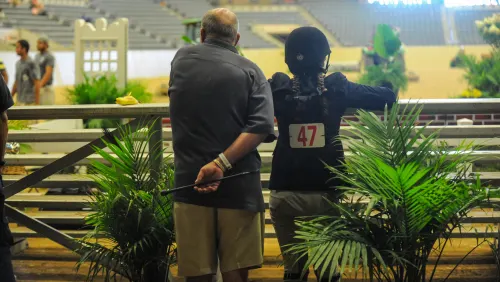For decades, show jumpers have lamented that in order to compete against the best in the world, they had to fly themselves and their horses all the way to Europe. With the notable exception of the 2000, 2003 and 2005 Budweiser World Cup Finals in Las Vegas, Nev., and the Spruce Meadows shows in Alberta, no North American venue has ever consistently enticed top-name riders to cross the ocean. Until now.
Gene Mische and the other organizers of the Winter Equestrian Festival have spent years building their three-month circuit into a thriving, bustling circus of rings, with thousands of hunters, jumpers and dressage horses competing at the highest levels. And now, they’ve fostered the Wellington Finale CSIO (p. 30) into a truly international affair. With the advent of the CN Nations Cup in 2002, this week at WEF has developed into something much more than just the end of the circuit in Wellington, Fla.
In its first year, the Nations Cup competition in Wellington hosted foreign teams from just Ireland, Argentina and Canada–comprised mostly of riders already based in Florida for the winter. But as the event grew in importance and popularity, foreign riders started making it a priority to get to Florida. In 2004, the class ran in the evening, under lights, for the first time, and it started to become a real spectator attraction. This year, 10 teams contested the class, and the atmosphere at the ring was boisterous and festive, as fans of the different countries waved flags, cheered and even sang.
And the crowd got to watch some of the biggest names in show jumping compete in both the Nations Cup and two days later in the CN U.S. Open Jumper Championship–Rodrigo Pessoa, Nick Skelton, Francois Mathy, Ian Millar, Herve Godignon, and many others. For any junior rider putting in long days at the equitation ring, this was a veritable cornucopia of talent laid out to watch, study and just enjoy. I can only hope that some of the aspiring grand prix riders in the crowd availed themselves of the opportunity.
ADVERTISEMENT
Mische and WEF officials have even expanded the international flair into the previous week–the Wellington Open CSI served as the kick-off for the Global Champions Tour, a series sponsored by CN Worldwide that offers a cash bonus for riders according to their placings at six CSI shows around the world.
With prize money in Euros, and riders from all over the world, the week had a distinct global feel. And by inaugurating the $200,000 FTI Rider Challenge, another cash-bonus program that awarded points in each grand prix held during the seven-week Wellington WEF season, they made competing at WEF even more attractive.
It’s a real challenge to make the last weeks of a seven-week show circuit exciting, different and interesting, but they’ve done it at WEF. The Nations Cup has not only developed into a thrilling spectator event, but it’s also drawn more and more international stars to the venue. The only drawback to this evolution is that the increased popularity has made for incredibly long days in the show rings–the grand prix ring went until 1 a.m. one day.
With the addition of more land to the WEF grounds, this circuit will assuredly continue to grow. Perhaps the CSIO could become a stand-alone event and bring more and more international stars to our shores. It’s already stepped up the level of competition in the United States by at least a notch or two, and our riders, young and old, can’t help but be inspired by that.














